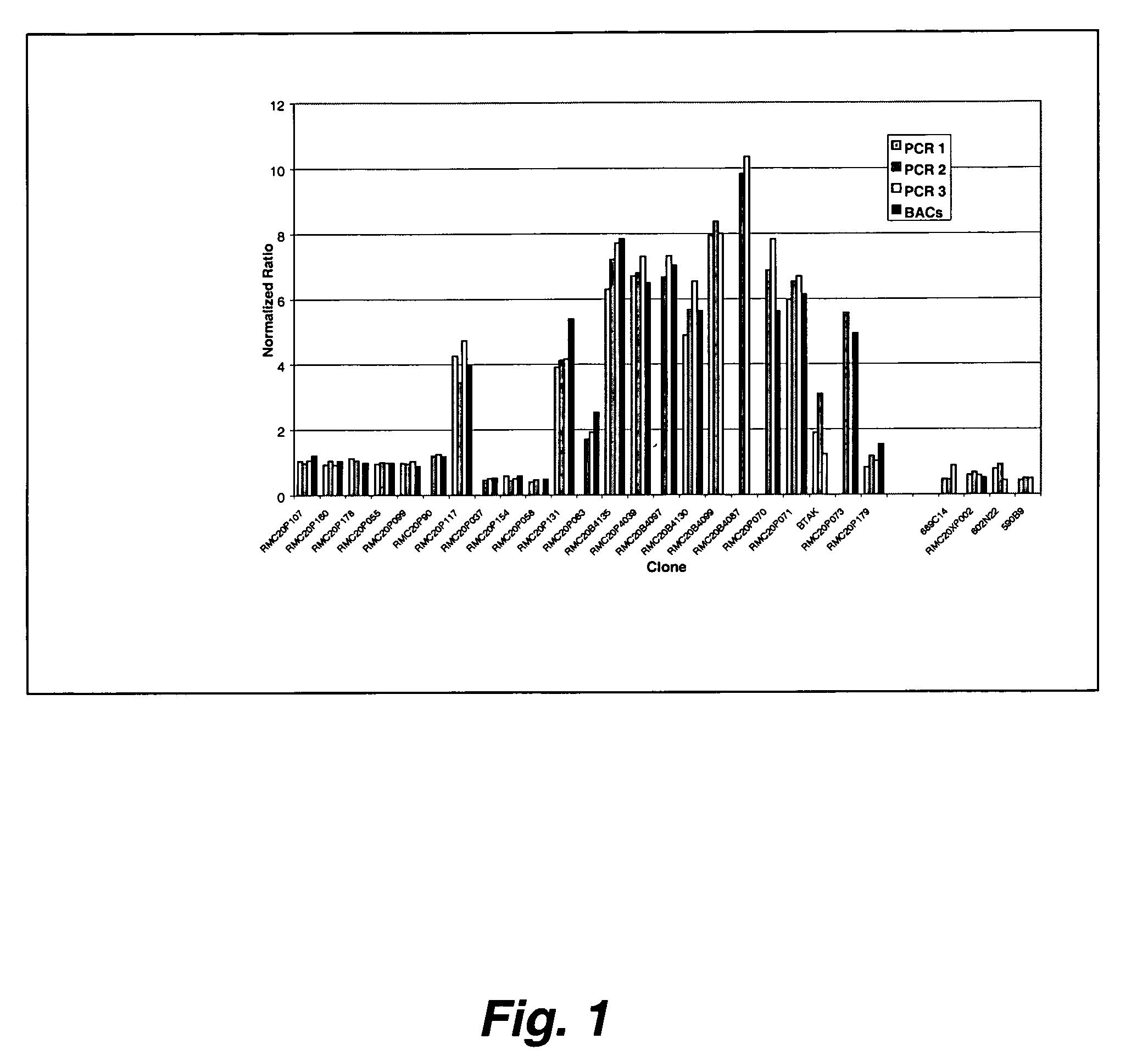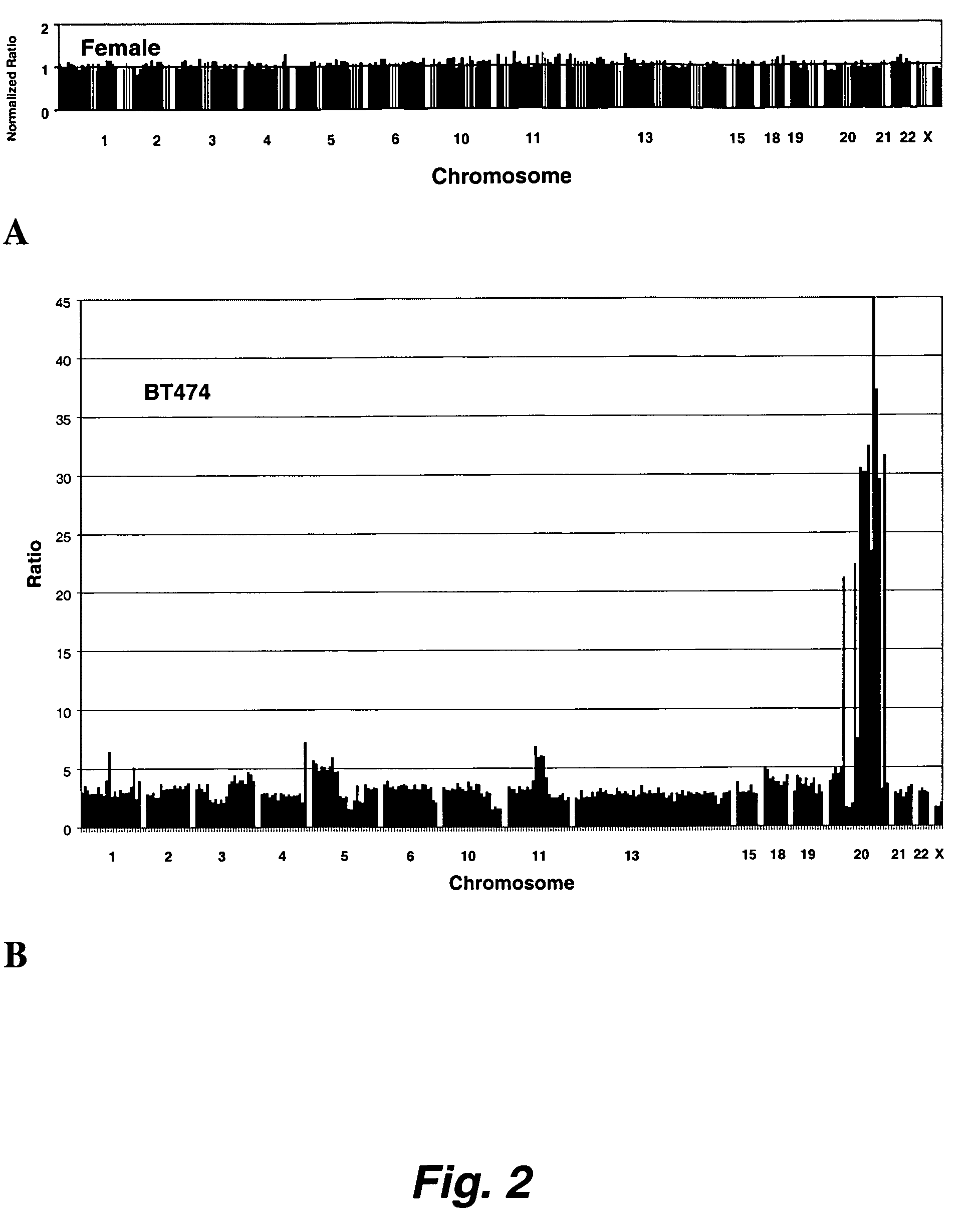Detection of nucleic acid sequence differences by comparative genomic hybridization
a technology comparative genomic hybridization, which is applied in the field of nucleic acid sequence differences detection by comparative genomic hybridization, can solve the problem of laborious mapping procedures of the momen
- Summary
- Abstract
- Description
- Claims
- Application Information
AI Technical Summary
Benefits of technology
Problems solved by technology
Method used
Image
Examples
example 1
Preparation of Target Solutions from BAC Clones by Lilation-Mediated PCR
[0270]This study addressed the problems of the continual need to grow BACs for DNA and the problems with viscosity in printing BAC DNA by generating a PCR representation of the BAC. Ligation-mediated PCR was used to produce large amounts of BAC DNA that could be used to make low-viscosity target solutions suitable for robotic spotting. In this procedure, the DNA was first digested with MseI, an enzyme with a 4-base recognition site to maximize the frequency at which the DNA is cut. An adapter was then ligated to the digested DNA and used to prime an initial PCR amplification. To make DNA for spotting, a second PCR amplification was performed using the first PCR product as template.
DNA Isolation and Restriction Enzyme Digest
[0271]Cultures of BAC clones from the RP11 human BAC library were prepared by inoculating 5 μl LB with 1 μl from individual glycerol stocks and allowed to grow overnight. The overnight culture...
example 2
Arraying of Target Solutions
[0278]Target solutions were printed on a substrate using a print head with multiple, closely-spaced printing tips. The printing tips were dipped into target solutions in 864-well microtiter plates, which permitted spacing the pins on 3 mm centers. The print head contained 16 pins (in a 4×4 arrangement) that produces 12 mm×12 mm arrays. Target elements were printed on approximately 150 μm centers.
[0279]The printing pins were made from quartz capillary tubes that were tapered toward the tip. A typical design had a 75 μm inside diameter tube that narrowed to a 25-50 μm opening at the tip. The pins were individually spring-mounted in the print head so that the pins could move independently. Each was connected by flexible tubing to a manifold that supplied pressure or vacuum as required. Each print cycle began with cleaning the pins by drawing cleaning solutions through them under vacuum. They were then dried in an air blast and dipped into the microtiter plat...
example 3
Detection of Sequence Differences Between Genomes Using Array CGH
Study Protocol
[0283]The sequence differences between M. musculus (strain NIH) and M. Spretus were detected by performing CGH using two genomic DNA samples, one from an individual from one of the parental mice, NIH, in the data presented below, and the other from an individual resulting from the backcross of an F1 individual with NIH. The genetic content of the F1, a cross between NIH and Spretus mice, was half Spretus and half NIH at all chromosomal locations. The chromosomes of the backcross mice were a mosaic of the genetic content of the two strains (due to crossover events during meiosis). Thus, these mice were either homozygous for NIH or heterozygous for NIH and Spretus DNA for a genomic locus. Array CGH was carried out to distinguish regions of homozygosity and heterozygosity in backcross mice. These regions of heterozygosity represent an average sequence divergence of 1% or less.
[0284]The basic procedure was si...
PUM
| Property | Measurement | Unit |
|---|---|---|
| transparent | aaaaa | aaaaa |
| concentrations | aaaaa | aaaaa |
| concentration | aaaaa | aaaaa |
Abstract
Description
Claims
Application Information
 Login to View More
Login to View More - R&D
- Intellectual Property
- Life Sciences
- Materials
- Tech Scout
- Unparalleled Data Quality
- Higher Quality Content
- 60% Fewer Hallucinations
Browse by: Latest US Patents, China's latest patents, Technical Efficacy Thesaurus, Application Domain, Technology Topic, Popular Technical Reports.
© 2025 PatSnap. All rights reserved.Legal|Privacy policy|Modern Slavery Act Transparency Statement|Sitemap|About US| Contact US: help@patsnap.com



